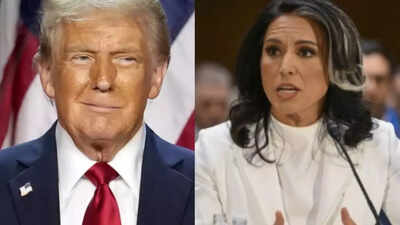‘I don’t care’: US intel said Iran wasn’t building nuclear weapon; Trump said no

US president Donald Trump on Tuesday dismissed reports from his own intel chief, who said Iran wasn’t building a nuclear weapon. When asked about a public statement from director of national intelligence, Tulsi Gabbard—who testified that Iran was not building a bomb—Trump replied: “I don’t care what she said.” He insisted that Iran was “very close” to building a nuclear weapon and aligned himself more with Israel’s prime minister Benjamin Netanyahu than with his own national security briefings.The US intelTulsi Gabbard, a former Democrat lawmaker and military veteran, was confirmed as Trump’s new intelligence chief earlier this year. In March, she told Congress: “The intelligence community continues to assess that Iran is not building a nuclear weapon and supreme leader Khamenei has not authorised the nuclear weapons programme he suspended in 2003.”
She also noted that Iran’s enriched uranium stockpile had reached record levels for a country without nuclear weapons, and that the US was monitoring the situation closely.However, Gabbard later said Trump’s remarks did not contradict her position. She claimed both were “on the same page”, blaming the media for stirring confusion.Not the first timeThis is not the first time Trump has challenged conclusions of US spy agencies. In 2018, he drew criticism for siding with Russian President Vladimir Putin over US intelligence on election interference.Now, in his second term, Trump is once again rejecting official intelligence findings—even though this time, his administration is filled with loyal allies, unlike his first term when he accused officials of being part of a “deep state.”Others’ takeUS military commanders have raised concerns about Iran’s capabilities. Accordin to news agency Associated Press, Gen. Erik Kurilla told lawmakers that Iran could produce enough nuclear material for ten bombs within three weeks—but he did not say how long it would take to build an actual weapon. Other unnamed officials in the administration suggested Trump’s concerns were not entirely misplaced. They pointed out that Iran’s uranium enrichment levels go far beyond civilian use. One senior figure said Iran was “as close as it can be without having one.”Even the International Atomic Energy Agency has noted that Iran has enough enriched uranium for several bombs if it chooses to make them. However, Iran maintains that its nuclear activities are peaceful.Latest Israel-Iran conflictIsrael launched a major military operation against Iran last Thursday, targeting its nuclear facilities and top military officials. Israel has warned it will not stop until Iran’s nuclear capabilities are fully dismantled. Iran hit back with missile attacks of its own, raising tensions further across the region.US President Donald Trump is now weighing a possible direct attack on Iran’s underground nuclear site in Fordow. Also follow: Israel-Iran News Live UpdatesA quick look at Iran’s nuclear history:
- A Cold War start: Iran’s nuclear programme began in 1957 with US support. The goal was peaceful energy use.
- Post-Revolution shift: After the 1979 Islamic Revolution, ties with the US broke down. Iran’s nuclear aims became a global concern, despite its commitment to the Nuclear Non-Proliferation Treaty (NPT), which prohibits the development of nuclear weapons.
- The enrichment debate: At the heart of the issue is uranium enrichment. Iran says it needs it for energy, but the same process can bring it close to bomb-making capability.
- The 2015 deal: In 2015, Iran struck a deal with six world powers to limit enrichment to 3.67%, cut its uranium stockpile, and scale back centrifuge use. In return, it got relief from global sanctions.
- Trump’s exit: In 2018, Trump withdrew the US from the deal, calling it flawed, and reimposed sanctions. Iran responded by breaching the limits—raising enrichment levels, using advanced centrifuges, and curbing international oversight.
- Near-weapons grade: By 2023, IAEA inspectors found uranium enriched up to 83.7%—just short of weapons grade (90%).
- Nuclear talks halted: Iran and the United States have held multiple rounds of talks since April to thrash out a new nuclear deal to replace the 2015 accord with major powers that Trump abandoned during his first term in 2018. After Israel’s attacks, Iran said it would not hold any more talks with the United States as long as Israeli strikes continued. It also accused the US of backing Israel.
Read: With eye on Iran, Trump to host Pak army chief Munir for White House lunch





